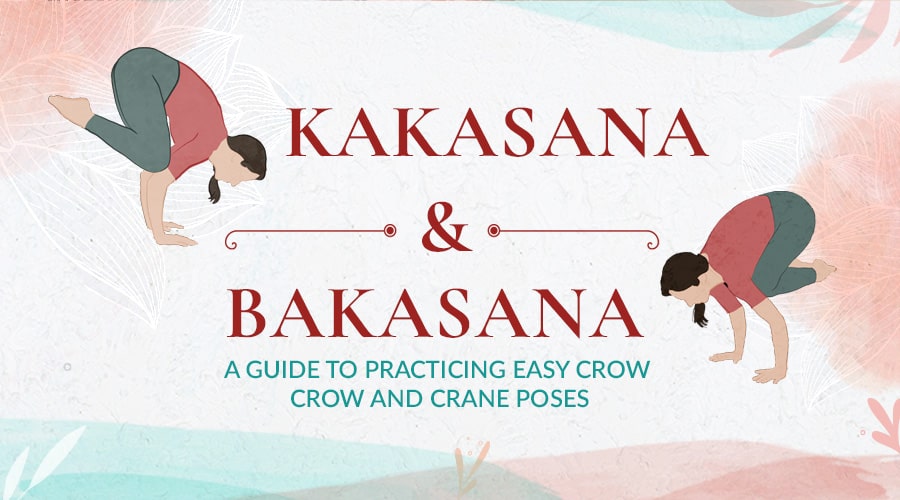Arm balance yoga poses like Crow and Crane Pose aren't just Instagram-worthy postures we practice for more likes. When practiced correctly, they can be deeply transformative, both physically and mentally. As a beginner, kicking into these poses can feel incredibly daunting at first. A forewarning, you will tumble and wobble in your first few dozen attempts—it’s completely normal, But, it's the grit and grace you develop while teetering on your hands that prepare you for life's bigger hurdles.
Having helped countless students take flight in Crow and Crane Pose successfully (and safely), this simple beginner's guide will define and demystify these gravity-defying poses. We'll explore the differences that set Kakasana and Bakasana apart, and I'll provide detailed, easy-to-follow instructions to help you practice these foundational arm balance poses with confidence.
What Is Crow & Crane Pose?
Crow Pose in Sanskrit is Kakasana; Kaka translates to “crow” and asana meaning “pose”. This is an arm-balancing yoga pose practiced in Hatha Yoga and other active yoga practices to strengthen the arms and core while increasing focus.
Crane Pose, or Bakasana, is an advanced balancing pose which shares a similar stance to Crow Pose. Although these poses might look alike on the mat and even stimulate the same muscles, they are not entirely the same.
Crow Pose vs Crane Pose - What Are the Differences?
Both Crow and Crane take on a similar shape on the mat: arms are planted on the mat balancing the upper body atop, while the knees tuck inwards and feet flex upward. Bearing a striking resemblance to perching birds, these poses are often confused and used interchangeably by practitioners. But, if you break down each of these poses, you’ll find that they are in fact different.
Crow Pose | Crane Pose |
|---|---|
Beginner to Intermediate | Intermediate to Advanced |
Arms bent and elbows at a 90-degree angle | Straight arms |
Knees rest on upper arms near the armpits | Knees rest on the back of the upper arms |
Torso parallel to the ground, hips higher | Torso and hips lifted, with a more vertical alignment |
Strengthens wrists, arms, and core | Improves arm strength and core stability |
Step-by-Step Guide to Practicing Crow & Crane Pose
Before we jump straight into it, read through the steps and visualize your body moving into the pose. The next step toward successful arm balances is to warm up your body with Sun Salutations. There are numerous reasons why you should never skip Sun Salutations in your daily practice; it wakes up your body, activating your muscles and balancing reflexes. Along with Pranayama (breathing exercises), these exercises also foster mental calm and focus.
Once warmed up, follow the step-by-step guide below for the preparatory Easy Crow Pose and practice until you feel comfortable and calm while holding the pose. Then, you are ready to move on to Crow, and finally, Crane Pose .
Many factors affect how long it might take you to become comfortable in Kakasana and Bakasana—anatomy, strength, balance and coordination, previous experience, state of mind, and more. There’s no perfect number of times to practice, and no quota of days, weeks or years your practice should take. The only rule is that regular practice will do far more good than occasional practice.
How to Do Easy Crow Pose (Sukha Kakasana)
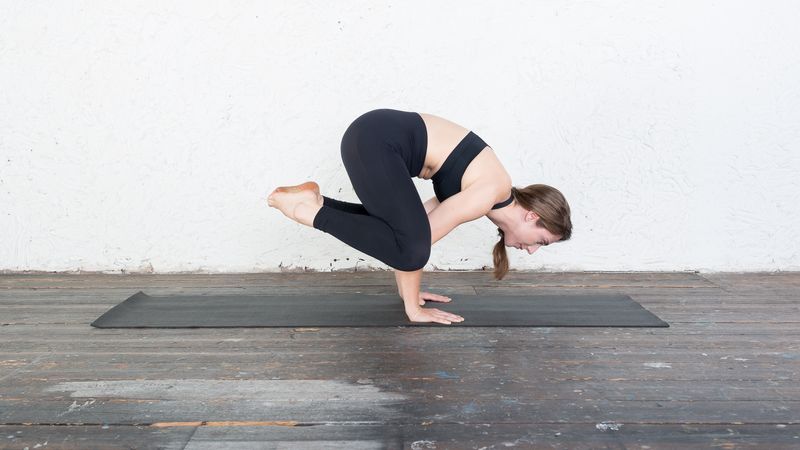
- Sit on your toes, with heels almost together and knees apart.
- Place your bent elbows in the crease of the inner side your knees. Your back should be slightly rounded.
- Keep your hands slightly higher than your knees, fingers spread apart and fingertips pointed slightly inwards.
- Maintain this alignment as you shift your weight forward, placing your palms on the floor roughly shoulder-width apart.
- Focus your gaze on a point half a meter (two feet) in front of your fingertips on the floor.
- Slowly lift your feet off the floor, one foot at a time.
- Pull both heels toward your hips, while looking at a point on the floor approximately 30cm (one foot) in front of your fingertips. Keeping these leg muscles engaged while holding the poses keeps your core active.
- Hold the pose briefly, then come out of it by shifting your weight backward with control, placing your feet on the floor and releasing your hands. (A beginner might work towards a ten second pose duration. With continued practice, a minute may become possible.)
Beginner Tips:
- The angle at your wrist should be 90 degrees. You can adjust this angle by placing a folded blanket under the heel of your palm. This sets the palm on an angle, taking some pressure off the wrist (see How to Prevent Yoga Wrist Pain for more wrist tips).
- If you’re struggling to ‘take off’, try pressing your forehead against a cushion on the floor to practice the weight shift.
Cautions:
- This pose is challenging for the wrists, shoulders, knees, groin and hamstrings, so please take into account any injuries or issues your body is dealing with. Cardiovascular issues or unmanaged hypertension might mean the pose is unsuitable for you.
Discover - Yoga for High Blood-Pressure
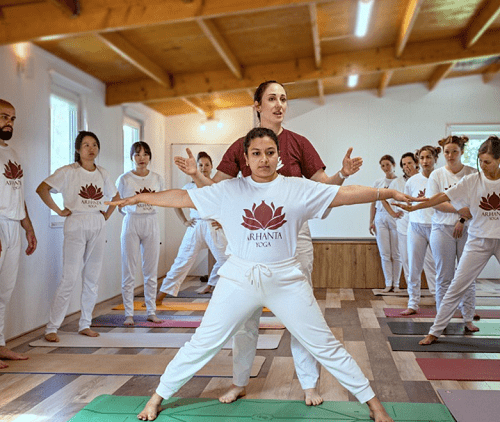
Experience authentic Hatha Yoga
Get free access to exclusive guided lessons with master teacher Kalyani Hauswirth-Jain
How to Do Crow Pose (Kakasana)
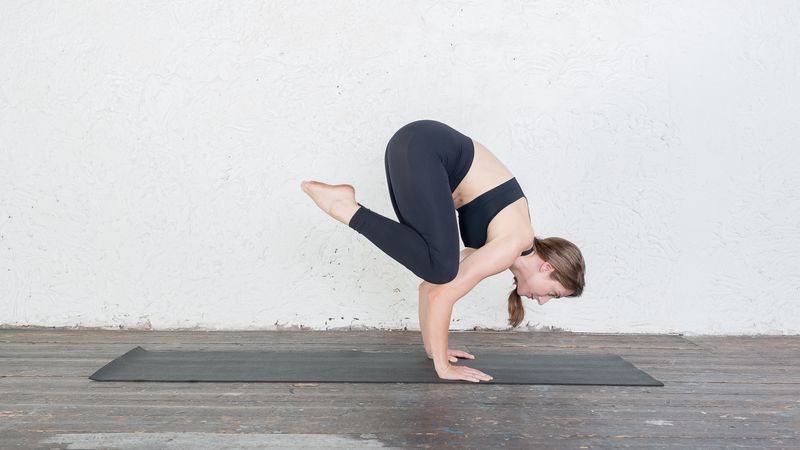
- Stand on your mat, with your feet shoulder-width apart.
- Bend forward, allowing your knees to bend and placing them against the back of your upper arms, just above your elbows.
- Maintaining the connection between your arms and knees, place your hands on the floor. Hands should be parallel, with fingers spread apart. Your back should be rounded, with the tailbone tucked in.
- Look forward toward the floor in front of you and shift your weight onto your hands. Actively push down through the heels of your palms, and your knuckles and fingertips.
- Lift your feet off the floor, one by one, and pull them up toward your hips. Keep your heels tucked towards your buttocks. Your big toes will be pointing slightly towards each other.
- If you are stable, press through your hands to straighten your arms as far as possible.
- Hold the pose steadily as long as comfortable and breathe evenly
See- What is Yoga Anatomy
Beginner Tips:
- When practicing Crow Pose in yoga, keep your head in a neutral position, looking at the floor in front of you. You can also lift your head a little to look slightly forwards—do this by lifting from the chest to avoid tilting the head too much and compressing the back of the neck.
- Wrist and balance tips as above: you can use a folded blanket under the heel of the palm to reduce wrist strain, and learn to balance the pose by practicing the weight shift with your forehead pressed onto a cushion on the floor.
Read: Best Yoga for Balance of the Body, Mind & Soul
Cautions:
- As for Easy Crow Pose (above)
How to Do Crane Pose (Bakasana)
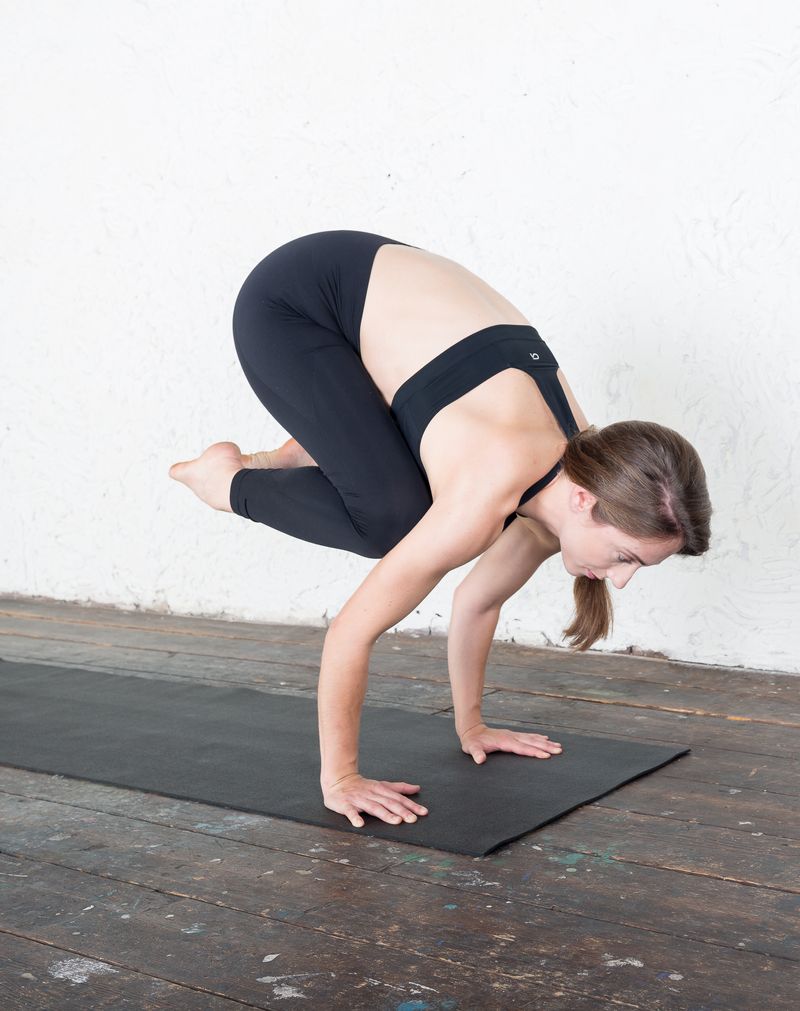
- Stand on your mat, with your feet shoulder-width apart.
- Squat halfway down, allowing your knees to open shoulder-width apart and focus on keeping your lifted heels toward each other. If balancing on lifted heels is difficult, start with a rolled blanket or block under your heels.
- Bend forward and place your knees as high up against your upper arms as comfortable, or in your armpits if possible. Your back will be rounded, your tailbone tucked in.
- Keep the connection between your arms and knees, and then place your hands on the floor. As in Crow Pose, hands are parallel and fingers are spread.
- Look forward to the floor in front of you and shift your weight to your hands. Again, push actively into the floor with your fingertips, knuckles and the heels of the palms.
- Lift your feet off the floor one by one, and pull them up toward your hips. Keep the heels tucked in toward your buttocks, and your big toes angled toward each other.
- Once you have control in the position, press through your hands to straighten your arms as far as possible.
- Hold the pose steadily as long as is comfortable. Breathe evenly.
Beginner Tips:
- Keep your knees glued high on your upper arms. Your arms should angle slightly forwards, so from a side view your shoulders are in front of your wrists.
- Neck and wrists tips: see tips in Crow Pose (above).
Cautions:
- As for Easy Crow Pose (above).
The Benefits of Crane & Crow Pose in Yoga
Crow Pose is usually the first arm balance pose practitioners attempt, before advancing into Crane Pose. If you’re struggling to find your balance in these postures and find yourself wanting to throw in the mat, remember these benefits you can reap from consistent (and correct) practice of Kakasana and Bakasana.
Strengthen Key Muscle Groups
Crow and Crane Pose are excellent for activating and strengthening crucial muscle groups in the body. Regular practice of these arm balance poses targets your core (trunk) muscles, along with arms and shoulders. This not only enhances muscle tone but also improves overall body strength.
Discover: The Ultimate Guide to Yoga for Strength and Flexibility
Improves Balance & Coordination
Kakasana and Bakasana require you to transfer your weight forward onto your hands while lifting your feet off the ground—a maneuver that demands deeper physical and mental focus. This shift of weight and center of gravity challenges your body’s usual balance mechanisms.
Successfully holding Kakasana and Bakasana also involves a mental component of balance. It requires concentration and body awareness to maintain the pose without tipping forward or backward, which is vital in all yoga practices.
Also Read - Uttanasana – Guide to Standing Forward Bend
Boosts Circulation & Lung Capacity
Incorporating arm balance asanas into your routine can significantly improve circulation and increase lung capacity. These poses demand a level of physical exertion that stimulates blood flow and encourages deeper breathing, which in turn enhances lung function and oxygen supply to your body.
Improves Core Control and Concentration
Both Crow and Crane Pose require a substantial amount of core strength and mental focus. Practicing these poses regularly can lead to improved core control, which is essential for overall physical health. Additionally, the concentration needed to maintain these poses helps to sharpen focus and mental clarity.
Stimulates the Sacral Chakra
An often-overlooked benefit of these poses is their ability to stimulate the Sacral Chakra (Svadhishthana Chakra). This chakra is associated with the lower abdomen, and its stimulation through Crow and Crane Pose can help balance the functions of the urinary tract, kidneys, and gonads, contributing to overall well-being.
Final Thought
To practice a strong and balanced Crow and Crane Pose, you will need to develop physical strength, coordination and mental focus. This takes time. Start where you are, do what you can, and most importantly, be consistent.
Once you have mastered these balancing poses, you can move on to more advanced variations like Side Crow Pose and Flying Crow Pose. By pushing your limits on the mat, you’ll not only progress in your practice but in your personal life as well.
For those looking to delve deeper into the world of yoga inversions beyond Crow and Crane Pose, this guide on how to practice yoga inversions is an invaluable resource.

Experience authentic Hatha Yoga
Get free access to exclusive guided lessons with master teacher Kalyani Hauswirth-Jain

